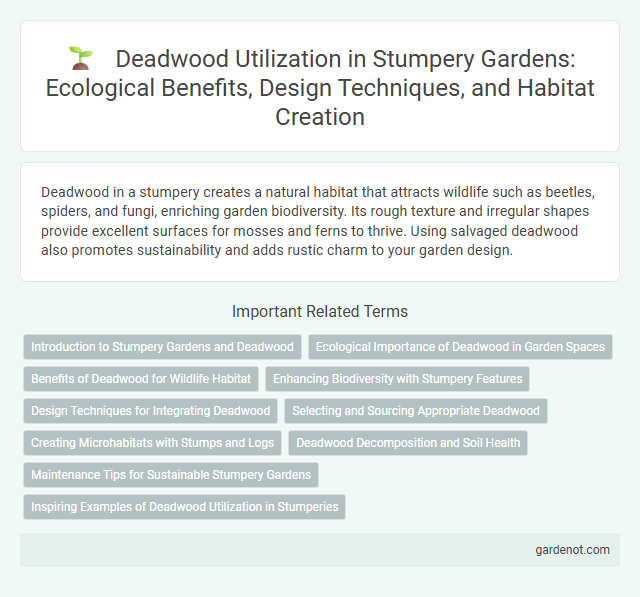Deadwood in a stumpery creates a natural habitat that attracts wildlife such as beetles, spiders, and fungi, enriching garden biodiversity. Its rough texture and irregular shapes provide excellent surfaces for mosses and ferns to thrive. Using salvaged deadwood also promotes sustainability and adds rustic charm to your garden design.
Introduction to Stumpery Gardens and Deadwood
Stumpery gardens showcase artistic arrangements of deadwood, transforming fallen tree roots and branches into natural sculptures that enhance woodland landscapes. Deadwood plays a crucial ecological role, providing habitat for fungi, insects, and wildlife, which supports biodiversity within these gardens. Integrating stumperies into garden design emphasizes sustainable practices by repurposing organic materials that would otherwise decompose naturally.
Ecological Importance of Deadwood in Garden Spaces
Deadwood serves as a critical habitat for a diverse range of insects, fungi, and micro-organisms, enhancing biodiversity within garden spaces. It plays a key role in nutrient cycling by decomposing organic matter and enriching soil health. Incorporating deadwood in stumperies supports natural ecosystems and promotes sustainable garden management.
Benefits of Deadwood for Wildlife Habitat
Deadwood provides critical habitat for a variety of wildlife species, including fungi, insects, birds, and small mammals that rely on decaying wood for shelter, food, and breeding sites. It enhances biodiversity by supporting decomposer communities essential for nutrient cycling, which maintains healthy forest ecosystems. Retaining deadwood in natural areas promotes ecological resilience by offering refuge and foraging opportunities during environmental stresses.
Enhancing Biodiversity with Stumpery Features
Deadwood stumperies create vital habitats for diverse fungi, mosses, and invertebrates, significantly boosting local biodiversity. Integrating fallen logs and branches into garden design provides shelter for pollinators and decomposers, fostering a balanced ecosystem. This natural approach supports nutrient cycling and encourages the proliferation of native plant species.
Design Techniques for Integrating Deadwood
Incorporating deadwood into stumpery design enhances natural aesthetics by creating textured layers and focal points that mimic woodland environments. Techniques such as strategically positioning gnarled branches and moss-covered logs foster a habitat for ferns, lichens, and shade-loving plants, improving biodiversity. Emphasizing asymmetry and organic shapes in deadwood placement supports a rustic, wild garden feel that harmonizes with native ecosystems.
Selecting and Sourcing Appropriate Deadwood
Selecting and sourcing appropriate deadwood for a stumpery involves choosing aged, naturally weathered wood that offers diverse textures and shapes to enhance visual interest. Optimal deadwood includes fallen branches, driftwood, and decayed tree roots collected sustainably from local forests or woodland areas to support ecological balance. Prioritizing dry, sturdy pieces prevents rapid decomposition while providing a stable foundation for mosses, ferns, and shade-loving plants commonly used in stumpery design.
Creating Microhabitats with Stumps and Logs
Deadwood plays a crucial role in creating microhabitats by providing shelter and breeding grounds for diverse species such as insects, fungi, and small mammals. Stumps and logs retain moisture, support fungal growth, and offer nesting sites that enhance biodiversity in forest ecosystems. Incorporating deadwood into stumpery designs promotes ecological balance and facilitates natural decomposition processes.
Deadwood Decomposition and Soil Health
Deadwood decomposition is a critical ecological process within stumperies, contributing essential nutrients to soil and enhancing microbial diversity. Fungi and detritivores break down lignin and cellulose in deadwood, facilitating nutrient cycling and improving soil structure. This decomposition helps maintain soil health by increasing organic matter content, promoting water retention, and supporting plant growth in forest ecosystems.
Maintenance Tips for Sustainable Stumpery Gardens
Deadwood plays a crucial role in maintaining a sustainable stumpery garden, providing habitat for beneficial insects and aiding soil health. Regularly check for signs of rot or pest infestation, removing any compromised pieces to prevent spread while preserving natural decay processes. Incorporating a mix of hardwood and softwood deadwood ensures structural longevity and diverse microhabitats, promoting balanced ecosystem function over time.
Inspiring Examples of Deadwood Utilization in Stumperies
Deadwood in stumperies serves as a rich habitat for mosses, ferns, and lichens, creating a naturalistic and biodiverse garden feature that mimics ancient woodland environments. Incorporating twisted roots, branches, and decayed timber enhances the textural complexity and visual intrigue, promoting habitat for insects and amphibians. Examples such as the Bodnant Garden stumpery in Wales highlight innovative deadwood arrangements that emphasize ecological value and artistic design within shaded garden spaces.
Deadwood Infographic

 gardenot.com
gardenot.com